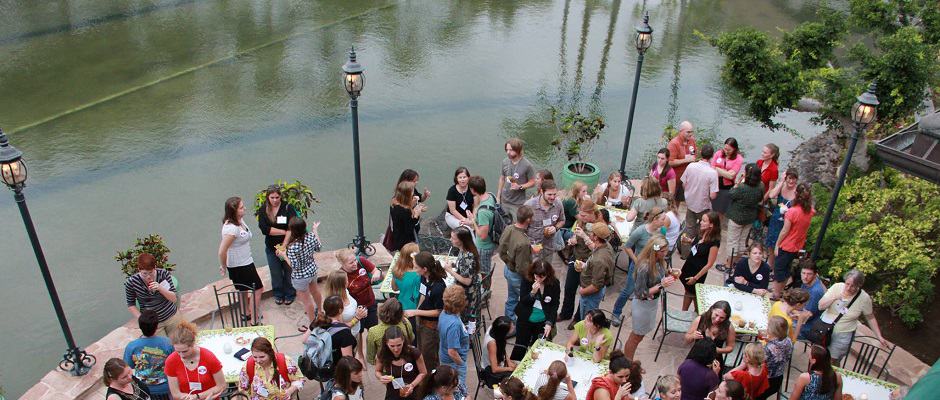
WOW networking event at TWS Annual Conference.
Annual Meeting
Women of Wildlife held their first gathering at the 2011 TWS Annual Conference in Hawaii. Each year since WOW has gathered at the Annual Conference for networking events and/or symposia.
For a detailed list of all events hosted or co-hosted by WOW, please visit see our WOW History.
2022 Annual Conference – Spokane WA
November 6-10
Panel Discussion: “Parenthood in the Field: Challenges and Advice for Raising Your Own Brood”
November 7, 2022, 3:30 – 5:00pm
Abstract: How do wildlife professionals balance their profession and parenthood? This career presents abnormal challenges as work schedules are not 9-5. This panel will provide an interactive forum aimed to improve how the wildlife field can better assist professionals into and during parenthood by (1) sharing personal stories on struggles and triumphs in work/life balance and (2) providing an open dialogue to discuss how workplaces can improve support. Dual-wildlife career parents, academics, NGO and government agency personnel will describe their transition and success into parenthood from the perspectives of various parenting roles.
Symposium: “Women in Wildlife Sciences: Building Equity, Diversity, and Inclusion”
November 9, 2022, 1:30-5:00pm
Abstract: This symposium features diverse speakers promoting diversity, equity, and inclusion in the field of wildlife conservation and management. We review history, analyze status, and celebrate achievements of women in wildlife. How to support women from classrooms to workplaces are described through stories and experiences from LGBTQ+, People of Color, Indigenous, and marginalized communities. We also provide practical advice on how to be an ally for underrepresented groups and describe proven models for methods to increase the inclusion of women in wildlife professions. This symposium highlights findings in a newly-published book, Women in Wildlife Science: Building Equity, Diversity, and Inclusion.
-
- From equity for women in the wildlife profession to a book topic? (Carol Chambers)
- Visible aspects of women in wildlife – current conditions. (Lisette Waits)
- Under the waterline – invisible aspects affecting how women work. (Kerry Nicholson)
- A state of hysteresis? (Diana Doan-Crider)
- Guided discussion of perspectives. (Amanda Veals, moderator)
- Breaking the binary. (Katie O’Donnell)
- Stories of support and setbacks. (Mamie Parker)
- #MeetTheMillenials. (Jenn Malpass)
- Multi-scale Approaches to Increase Inclusion. (Tabitha Graves)
- Guided discussion of what’s next. (Jamila Blake, moderator)
WOW Reception and Book Signing
November 9, 2022 7:30-9:30pm
JHUP publisher will present copies of our newly-published book, Women in Wildlife Science: Building Equity, Diversity, and Inclusion to sign and sell while we mingle!
Symposium: “Women at Work: Stories of Wildlife Research and Management”
November 10, 2022 – 8:30-:12:00 pm
Abstract: The symposium focuses on the work of women biologists. The goal of this symposium is to have a series of presentations on wildlife research and management topics that exemplify the leadership roles that women play within the scientific realm of wildlife biology. We believe that highlighting the amazing and diverse work that women contribute to the field of wildlife biology in a symposium such as this can normalize women as leaders in this field as well as provide role models to younger members of TWS as they forge their career paths in the wildlife profession.
-
- Researching the ecology of mama black bears while navigating my own experience of motherhood. (Heather Johnson, US Geological Survey Alaska Science Center)
- Prioritizing landscapes for wildlife refuges in the age of climate change. (Mindy Rice, US Fish and Wildlife Service)
- Combating anthropogenic stressors using conservation behavior to improve environmental health and species. conservation (Elizabether Peterson, Colorado State University Pueblo)
- Researching biodiversity in managed forests: a multi-taxon approach. (Angie Larsen-Gray, National Council for Air and Stream Improvement, Inc.)
- Bridging the gap between academics and wildlife managers. (Rachael Urbanek, University of North Carolina Wilmington)
- Taking the long view: rewards and challenges in long-term research. (Evelyn Merrill and Mark Hebblewhite, University of Alberta and University of Montana)
- A non-traditional pathway to working with wildlife: studying less charismatic fauna. (Virgina Seamster, New Mexico Department of Game and Fish)
- Multiscale habitat relationships of a habitat specialist over time: the case of ocelots in south Texas 1982-2017. (Amanda Veals et al, Borderlands Research Institute)
- Looking under the log, a 20-year retrospective look at the decaid advisory tool for snag and down wood management in the Pacific Northwest. (Barbara Garcia, USDA Forest Service)


